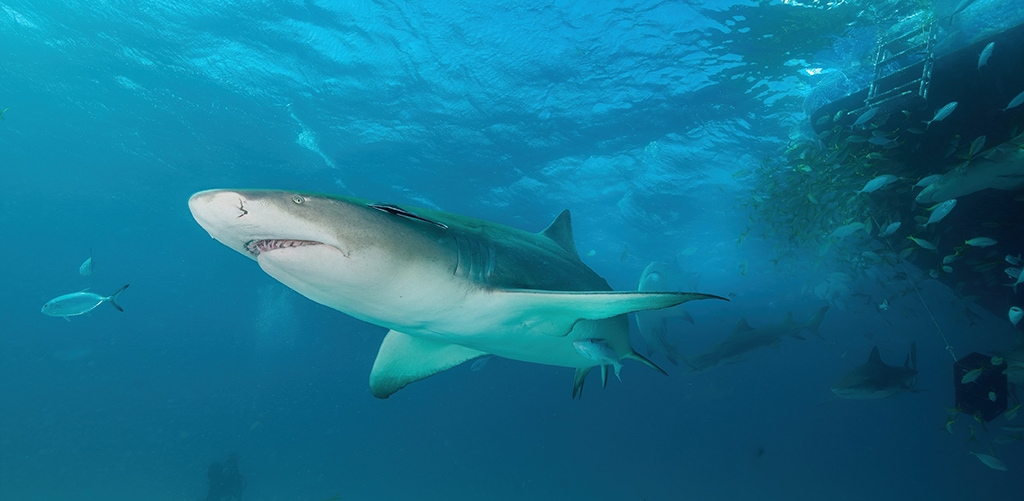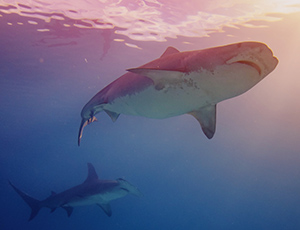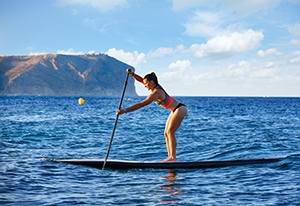The ocean offers great conditions for stand up paddle boarding. There’s nothing quite like calm clear water or gentle waves softly rocking your board on a bright sunny day.
But the ocean can be as dangerous as it is beautiful.
You’ll be sharing the ocean with scary animals, including sharks, which attack surfers, kayakers, and other water users. It’s perfectly normal to be worried about a possible paddle board shark attack.
While sharks do attack paddle boarders, it’s not something that should keep you from exploring the ocean on your SUP.
Here’s why.
Key Takeaways
- Shark attacks on paddle boarders are rare and usually unprovoked, meaning the shark is curious, threatened, or mistaken.
- Only three shark species are notorious for attacking humans: great white, bull, and tiger sharks.
- To minimize the risk of shark attacks, paddle boarders should avoid wearing high-contrast colors and shiny jewelry and paddling at dawn or dusk.
- If you spot a shark, stay calm and paddle slowly to the shore without making erratic movements. Don’t approach or try to touch a shark!
- Paddle boarding in the ocean is a rewarding activity that should not be avoided because of shark fears but should be done with respect and caution.
How Often Do Shark Attacks Occur?
Shark attacks aren’t as common as you may think. According to the International Shark Attack File, there were 57 unprovoked shark bites in 2020 and 39 provoked bites, worldwide. In total, there were 13 shark attack fatalities.
33 of the unprovoked attacks happened in the United States, with 16 of them happening in Florida and 5 in Hawaii. Three of the 33 cases were fatal.
Australia had 18 cases of unprovoked attacks, the second-highest number, 6 of which were fatal.
Looking at the recorded incidents over the years, the United States has the highest number of unprovoked attacks, followed by Australia. South Africa comes third.
There are hundreds of shark species, but only three of those are notorious for attacking humans. They include the great white shark, bull shark, and tiger shark.
Considering the fact that there are about a billion sharks in the water worldwide and hundreds of millions of water users, shark attack cases are rare. It’s just that every time it happens, it attracts a lot of attention and media coverage.
Do Sharks Really Attack Paddle Boarders?
Cases of sharks attacking paddle boarders definitely aren’t unheard of. The ocean is a sharks’ home and as long as you’re there, there’s a chance of getting attacked (albeit really slim).
In 2019, a tiger shark bit Larry Orbeto’s SUP board as he was paddle boarding, and the inflatable board started deflating. Thankfully, there was another paddle boarder nearby so he got on his SUP and they paddled to the shore.
Cleveland Bigelow, a SUP surfer, had a similar encounter in 2017 while SUP surfing in Cape Cod. A white shark took a bite off his SUP but lucky for him, it wasn’t an inflatable SUP so it didn’t deflate.
The bottom line is that anyone in the ocean can suffer a shark attack, and that includes a stand up paddle boarder.
Provoked Vs Unprovoked Shark Attacks
Provoked attacks are those that occur after a human first provokes the shark. For instance, a person could get bitten trying to feed or touch a shark. If you see a shark going about its business and you try to disturb it, you shouldn’t be surprised if you get attacked. It’s only natural for the creature to try and defend itself.
An unprovoked attack, on the other hand, occurs unexpectedly, without the human trying to interact with the shark. You may not even be aware that there’s a shark around and that’s terrifying.
An unprovoked attack could be a sneak attack, where the shark sneaks up on you from behind. It could also accidentally hit your SUP and quickly swim away or knock your board to make you fall off and then attack.
Why Would a Shark Attack a Paddle Board?
Humans aren’t exactly a shark’s favorite meal. Judging by the population of sharks and the number of people in the water each year, you can conclude that sharks are not actively hunting humans. If they were, the number of attacks would be much higher.
So what would prompt a shark to attack a paddle board unprovoked?
1. The Shark Is Curious
If you see something strange around your home, you usually want to go over and investigate. It’s the same for a shark when it sees paddle boards and hears splashing and yelling. It might get curious and approach you.
2. They Find Your Paddle Board Threatening
Stand up paddle boards are not small, and they can make a shark feel threatened. In an attempt to protect itself from the “threat”, a shark may attack. Sudden aggressive paddling movements won’t help the situation.
3. Your SUP Looks Like a Snack to Them
Sometimes, a shark can mistake your paddle board for food. You’ve seen in some cases where SUP shark attacks occurred the animals bit off huge chunks of the board, probably hoping to end up with a mouthful of juicy flesh and not fiberglass.
How to Prevent a Paddle Board Shark Attack
If you will be paddle boarding in the ocean, you have to consider the possibility of running into a shark. Here’s how you can minimize the risk of getting attacked by one.
1. Stay Alert
Stand up paddle boarding is such a relaxing activity. It’s easy to get lost in the peacefulness and beauty of your surroundings. You may not even realize that there’s a shark swimming around you.
Always be aware of what is happening.
2. It’s Their Home, Give Them Space
Give sharks the respect you’d give any other dangerous wild animal. While you may be tempted to pet them, play with them, and maybe take a few cool photos, that could cost you a limb or even your life.
Don’t go paddle boarding in areas where there has been a shark sighting.
3. Watch the Colors You Wear
You may have heard people say that sharks are attracted to the color yellow and this has some truth in it.
Sharks don’t have a single color that they prefer – because they can’t really distinguish colors. They will, however, be attracted to high-contrast colors, including red, yellow, and orange. These colors contrast with the water environment, making them easy to spot – and sharks will find them interesting.
This can cause a bit of an issue, as we all know that some paddle boarding gear is brightly colored to make it easier for humans to spot (and also because it can look kind of cool). But if you’re concerned about sharks, or if you’re paddling in an area where sharks have attacked before, then you might want to give the bold colors a miss.
You should also leave your shiny jewelry at home. It could reflect the sun, just like the scales of fish, making a shark think you’re its next meal.
Speaking of…
4. Avoid Shark Meal Times
Sharks can eat any time as long as there’s prey, but they commonly feed at dawn and dusk. These are the times you want to avoid so you don’t find yourself on the menu.
While it might be tempting to enjoy the sunrise on the water – it’s better to exercise caution if shark attacks are a genuine concern for you.
5. Go with a Friend
When a shark bit off Larry Orbeto’s inflatable SUP, he was lucky enough to have someone else with a paddle board nearby. It helps to go paddling with a friend or let someone know you’ll be out on (and in) the water.
What To Do If You Spot a Shark While Paddle Boarding
If you find yourself paddling alongside a shark, try to stay calm. It’s easier said than done but you don’t want to make erratic movements, as these might attract or scare the shark, leading to an attack.
Remain calm and carefully start paddling to the beach.
Wrapping Up
Do sharks attack paddle boarders? Yes, sharks can attack anyone in the water, and that includes paddle boarders.
However, statistics show that shark attacks are very rare. Only three of hundreds of shark species are likely to go after water users. These are white sharks, tiger sharks, and bull sharks.
Always respect the water and give the animals that live in it their space. Don’t try to touch or feed sharks. Also, avoid wearing contrasting colors and shiny jewelry. When you spot a shark, remain calm and slowly paddle back to shore.
Happy paddling!



